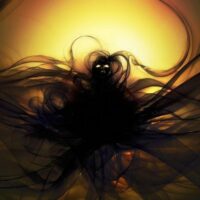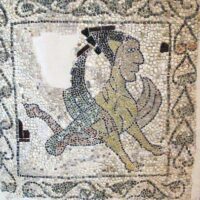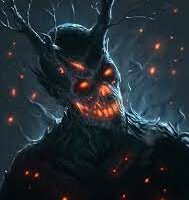Mormo : The Spirit of Sorrow
Listen
At a glance
| Description | |
|---|---|
| Origin | Greek Mythology |
| Classification | Spirits |
| Family Members | N/A |
| Region | Greece |
| Associated With | Death, Sorrow |
Mormo
Introduction
Mormo, often mispronounced as Morno, emerges as a significant presence in Greek mythology. Originally depicted as a terrifying female spirit, her name, meaning ‘terrible’ in Greek, was invoked by caregivers to instill discipline in children. Amidst the tapestry of Greek myths, Morno occupies a distinct niche, embodying elements of darkness and mystery. While Olympian deities dominate the spotlight, Morno’s enigmatic presence threads through lesser-known narratives, leaving behind cryptic symbols and ambiguous actions.
Within the rich tapestry of Greek mythology, where gods, heroes, and fantastical beings abound, certain figures dwell in shadow, their tales whispered in fragments. Morno, evoking a sense of impending doom, epitomizes such elusive entities. Unlike the well-documented exploits of Zeus or the poignant sagas of heroes like Odysseus, Morno’s story eludes complete comprehension, leaving scholars and mythologists to reconstruct a fragmented portrait.
Physical Traits
While ancient texts offer scant descriptions of Mormo, she is frequently associated with horses and wolves, hinting at possible equine traits and shape-shifting abilities. Depictions often highlight Mormo’s distinctive features, including large ears and an elongated tongue, underscoring her reputed capacity for metamorphosis. Describing Morno’s physical form parallels capturing twilight’s essence. Veiled in shadow, he emerges as a figure obscured by dusk’s dim light. Some narratives emphasize his piercing, luminescent eyes, seemingly repositories of cosmic secrets. Others portray him as a shape-shifter, seamlessly blending into the darkness he commands. Morno’s allure exudes an eerie mystique, captivating both mortal and immortal beings.
Morno’s physical attributes remain elusive in ancient lore. Speculations suggest he embodies abstract concepts like mortality, oblivion, or sorrowful lamentation. Translated as “gloomy” or “sad” in ancient Greek, Morno’s name hints at a somber, perhaps skeletal figure. Yet, the absence of definitive details allows for varied artistic interpretations. Imaginings depict Morno as a cloaked entity enshrouded in perpetual darkness, his countenance veiled, symbolizing the enigma beyond mortal comprehension.
Family
Morno’s familial origins remain as enigmatic as his elusive presence within Greek mythology. Scholars debate two primary theories regarding his lineage, each offering unique insights into his character. One theory proposes Morno as the offspring of Nyx, the primordial goddess of night, aligning with his melancholic temperament and potential association with the realm of death. Within this framework, Morno emerges as a lesser deity dwelling within the shadowy domain of his mother, embodying facets of night such as its somber silence or the inevitability of mortality.
Alternatively, Morno is suggested to be the progeny of the ancient titans Okeanos and Tethys, representing the vast ocean and its freshwater source, respectively. Despite the apparent contradiction with his association with night, this lineage implies that Morno symbolizes the profound, sorrowful tranquility of the ocean’s depths—an abyss steeped in secrets and forgotten souls. These contrasting theories offer tantalizing glimpses into Morno’s ambiguous nature, leaving scholars to decipher the true essence of his origins.
Beyond his familial ties, Morno is known by various names across different regions and mythological traditions. Referred to as Moros, he embodies the specter of impending doom and fate in some narratives, while others recognize him as Thanatos, the god of death whose touch seals mortal existence. These diverse appellations underscore the complexity of Morno’s character, transcending conventional categorizations and inviting deeper exploration into the enigmatic realms of Greek mythology.
Other names
The mystique surrounding Morno extends beyond his elusive presence in Greek mythology to the ambiguity surrounding his alternate names or epithets. This lack of established nomenclature further complicates scholars’ efforts to unravel his role within the divine hierarchy. However, drawing from his potential association with Nyx, some scholars propose hypothetical titles that might shed light on his enigmatic nature. Among these conjectures, “Moros,” meaning “doom” or “fate,” emerges as a conceivable epithet, potentially encapsulating a specific aspect of Morno linked to the inexorable inevitability of mortality.
In a parallel vein, “Thanatos,” representing the serene embodiment of death, offers another avenue of exploration. If Morno indeed embodies a more somber or melancholic aspect of the transition from life to death, this epithet may hold particular relevance, highlighting his role in the cosmic cycle of existence. Yet, while these speculative names offer intriguing avenues for interpretation, the true essence of Morno’s identity remains veiled in uncertainty, inviting further contemplation and scholarly discourse.
Beyond these conjectural titles, Morno’s enigmatic persona intertwines with other mythological entities, blurring the boundaries between his identity and that of other beings. Frequently equated with figures such as Lamia, Gello, or the strix—a vampiric bird of the night known for preying on children—Morno’s identity becomes intertwined with a broader tapestry of mythological symbolism. Additionally, the historical usage of “Mormolycia” to describe grotesque masks in ancient Greek theatrical performances hints at the diverse cultural contexts in which Morno’s name has been invoked, further enriching the tapestry of his enigmatic legacy.
Powers and Abilities
Morno’s realm of influence stretches as vast and impenetrable as the night sky itself. As the embodiment of twilight and darkness, he commands the shadows, intricately weaving them into webs of illusion and allure. Myths echo with tales of his unseen traversals between mortal realms and divine domains, hinting at a mastery over unseen boundaries. Prophecy whispers of his ability to peer through the veils of time, glimpsing fragments of the future. Yet, Morno’s true might lies not in grand displays of power, but in the subtle sway he holds over the hearts and minds of mortals.
In contrast, Mormo’s power emanates from the primal fear she instills in those who cross her path. Linked to horses and wolves, symbols of adaptation and transformation, she embodies the duality of human nature, capable of shape-shifting and blending seamlessly into the shadows. While her abilities remain shrouded in mystery, her capacity to evoke dread stands as a testament to her formidable presence.
However, Morno’s powers remain a subject of conjecture due to the scarcity of concrete information. Theories abound regarding his potential functions, ranging from inducing sorrow and despair to serving as a harbinger of death, foretelling the mortal coil’s final embrace. Some speculate he may assume a role akin to that of Hades or Persephone, safeguarding the realms of the dead, ensuring souls remain within the confines of the underworld. Amidst the ambiguity, Mormo’s essence persists as an enigmatic force, beckoning seekers to unravel the mysteries veiled within the shadows of ancient myth.
Modern Day Influence
Despite her scant presence in ancient mythology, Mormo’s influence has endured in popular culture. References to Mormo abound in various media, from H. P. Lovecraft’s ‘The Horror of Red Hook’ to appearances in animated series like Scooby-Doo and film adaptations such as Neil Gaiman’s ‘Stardust.’ Though largely overlooked in mainstream discourse, Mormo’s essence resonates in modern-day concepts, serving as a precursor to certain contemporary themes.
One such theme is embodied in the Grim Reaper, a skeletal figure synonymous with death in Western culture. The thematic parallels between the Grim Reaper and a potential portrayal of Mormo underscore the enduring fascination with mortality and the afterlife. Moreover, Mormo’s nebulous nature as an entity associated with darkness and sorrow aligns with modern literary tropes that personify abstract concepts like death or despair. In this light, Mormo serves as an early exemplar of a literary device commonly employed in contemporary fiction.
Furthermore, Mormo’s enigmatic presence reflects humanity’s perennial intrigue with the unknown. The scarcity of details surrounding her character hints at the vastness of Greek mythology and the boundless potential for further exploration and interpretation. In essence, Mormo’s legacy transcends antiquity, leaving an indelible mark on modern culture and inspiring ongoing exploration of the human psyche and the cosmos.
Related Images
Frequently Asked Questions
What is lorem Ipsum?
I am text block. Click edit button to change this text. Lorem ipsum dolor sit amet, consectetur adipiscing elit. Ut elit tellus, luctus nec ullamcorper mattis, pulvinar dapibus leo.
What is lorem Ipsum?
I am text block. Click edit button to change this text. Lorem ipsum dolor sit amet, consectetur adipiscing elit. Ut elit tellus, luctus nec ullamcorper mattis, pulvinar dapibus leo.
What is lorem Ipsum?
I am text block. Click edit button to change this text. Lorem ipsum dolor sit amet, consectetur adipiscing elit. Ut elit tellus, luctus nec ullamcorper mattis, pulvinar dapibus leo.
What is lorem Ipsum?
I am text block. Click edit button to change this text. Lorem ipsum dolor sit amet, consectetur adipiscing elit. Ut elit tellus, luctus nec ullamcorper mattis, pulvinar dapibus leo.
What is lorem Ipsum?
I am text block. Click edit button to change this text. Lorem ipsum dolor sit amet, consectetur adipiscing elit. Ut elit tellus, luctus nec ullamcorper mattis, pulvinar dapibus leo.







